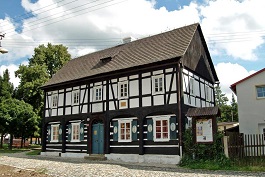
The house of the painter Josef Führich in Chrastava has opened to visitors
 |
Josef Führich is considered one of the most significant artists of the 19th century. Nevertheless, his name has faded into obscurity in his native Bohemia. He lived from 1800 to 1876. His youth was connected with the German-speaking community in northern Bohemia. He mainly drew and painted religious themes, and his works can be found in the local church in Chrastava, while his childhood home also features drawings from Czech history and legends. "He was one of 12 children, but only two reached adulthood," said Klára Sehnoutková from the Chrastava information center, who guided visitors through his house today.
"Thanks to the support of Count Clam-Gallas, the gifted Josef was able to study in Italy, Austria, and Germany. When he returned to Chrastava, he also supported it financially. When some houses burned down here, he sent a substantial amount for their reconstruction," Sehnoutková added. Führich sent his sister drawings from his travels, which are now on display in his childhood home. These likely served as inspiration for the decoration of one of the upper rooms, which features an Italian landscape. "The author was probably his sister Marie, not Josef himself, as was originally believed," the guide added.
Führich's house is not, in the strictest sense, his birthplace. The original house burned down in 1802 when Josef was two years old. His father rebuilt it. "It is the house where Josef Führich lived and grew up," Sehnoutková said. In the timber-framed building with a shingle roof, there is original furniture decorated by Führich's father. The house contains Josef's drawings and pictures, as well as a moving nativity scene and figures that he painted and cut out together with his father.
The house of painter Führich is a unique example of architecture typical for the Czech, German, and Polish parts of the Euroregion Nisa. The so-called timber-framed houses likely appeared as early as the 15th and 16th centuries. They combine timber framing and block construction. The block living room - similar to a wooden trunk - is surrounded by a supporting structure that supports the roof or the upper floor of the timber-framed or log construction. This supporting structure - the timber frame - gave the houses their name. For centuries, this structure has been adapted to new demands, and similar houses were still being built in the 19th century. In northern Bohemia, Upper Lusatia, and Lower Silesia, approximately 19,000 of them are estimated to have survived.
The English translation is powered by AI tool. Switch to Czech to view the original text source.
0 comments
add comment
Related articles
0
28.09.2012 | A new Art Nouveau bridge will open in Chrastava
0
17.10.2011 | Chrastava has three unique lifting bridges and is preparing a fourth one
5
26.10.2010 | Unique cable car over the river in Chrastava has finished, it was looted
0
10.10.2010 | The footbridge in Chrastava washed away by the flood has been replaced by a transbordeur











